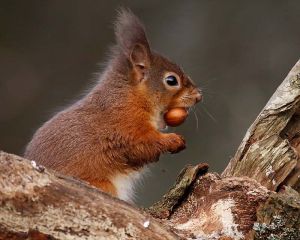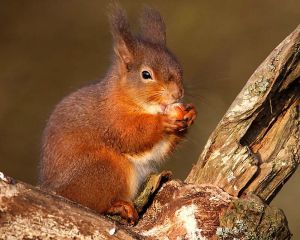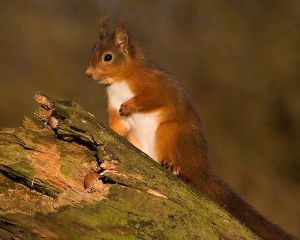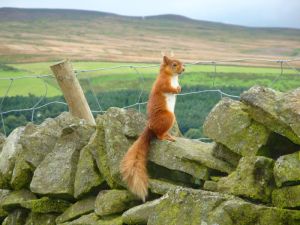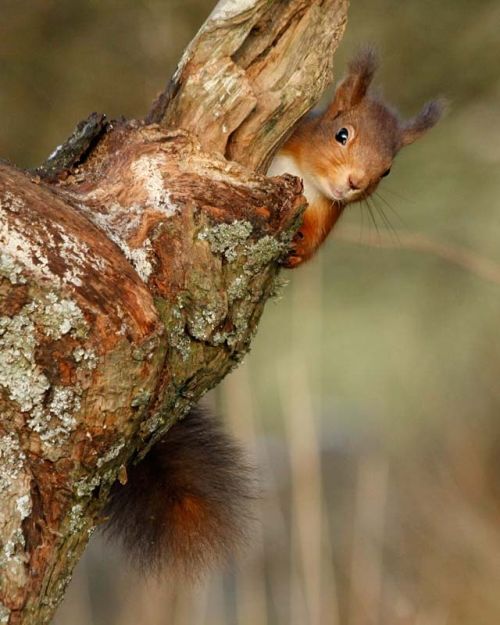Accessible self-catering holiday cottage in Northumberland
Situated at Bingfield near Hexham Northumberland
Home/Accommodation Facilities Prices/Availability Contact/Map Guest reviews Accessibility Attractions Environment Links News
Northumberland's red squirrels
20 years ago the "grey" squirrel population was not present in Northumberland and predictions state that in 10 years time there may not be any reds left.
Northumberland has been described as England's last bastion for the red squirrel.
There is link between the arrival of grey squirrels and the disappearance of red squirrels in an area. This is because grey squirrels can live in higher numbers than reds in native broad leaved woodlands where there are large seeded trees such as oak and hazel. Greys use up the resources forcing the reds out. In addition, grey squirrels can carry a virus called parapox which they do not seem to suffer from, but which can be fatal to reds. When grey squirrels arrive in an area they can pass on this virus on to the reds.
The only way to protect the red squirrel and other wildlife in Northumberland is to stop the spread of the grey squirrel.
Simon and I are eager to help to protect the native red squirrels in the local area. The Hytte is a sponsor of Squirrel Action Greenhead & Gilsland (S.A.G.G.).
This group was formed in March 2007 to try to protect the red squirrel population in the area which is now under threat from invading grey squirrels. S.A.G.G is committed to working together to achieve our common goal
The continued and flourishing existence of our much-loved native red squirrel.
Natural History of Red Squirrels
Distribution
The red squirrel can be found across Europe and Asia, from the Arctic Circle in the north to the Mediterranean Sea in the south, and from China in the east to Britain in the west. Interestingly, it is only in Britain where the red squirrel is threatened, although some populations in northern Italy are also declining. Both of these areas have also been subject to the release of American grey squirrels, supporting the belief that red squirrels are being replaced by this non-native species wherever it is introduced.
Squirrel Spotting
Red squirrels have fur which ranges from blonde or pale orange, through deep reddish-brown to almost black ear tufts (which are easier to spot in winter) and bushy tails, which may bleach lighter in spring and summer. Some red squirrels can have greyish flanks in summer, but their ear tufts and tail (uniformly all one colour) mean that they can be distinguished from grey squirrels, which are stockier and heavier, with mouse-like ears and a halo of white around their tail.
Master of the Trees
Red squirrels are well adapted to the woodland habitat in which they live, their light weight and agility enabling them to reach the thinnest branches at the tops of trees. They use their tails for balance, and double-jointed ankles and long claws help them to hold on when running up and down tree trunks. If they are disturbed, they will often 'freeze' for 5 to 10 minutes, pressing themselves against the trunk of the tree until they think it is safe to move again.
Squirrels have long whiskers which they use to find their way around inside their drey.
Red squirrels eat a variety of different foods throughout the year. They are adapted to living and foraging in woodlands, where their main diet is composed of seeds, nuts, buds, leaves, flower shoots and the fruit of many trees and shrubs, fungi, bark, lichen, insects and occasional bird's eggs. The autumn and winter seed harvest is extremely important, both for survival through the winter months, and to ensure breeding success the following spring.
Chewed and stripped pine cones and broken nut shells (often found scattered below a favourite feeding branch or on tree stumps) are clues to show where a squirrel has been feeding. Squirrels can even tell good nuts from rotten ones by weighing them and shaking them in their paws. If the nut rattles, the kernel is likely to be small and shrivelled, and not worth eating.
Where Do Squirrels Live?
A squirrel's home is called a drey. A red squirrel will build its drey close to the main trunk, or in the fork of a tree and is used both for rearing young and nocturnal shelter. The drey consists of a hollow ball of twigs and leaves, which is then lined with soft hair and moss. Summer dreys may also be constructed, which are flat, less protective structures used for resting during daylight hours.
As an alternative to dreys, some squirrels may use natural holes in trees which are known as dens.
Places in Northumberland/Cumbrian Border to see Red Squirrels
Hareshaw Linn, a popular walk from the village of Bellingham to a picturesque waterfall. The path follows the Hareshaw burn along a wooded gorge.
Allen Banks and Staward Gorge Gorge of the River Allen with ornamental and ancient woodland.
Allen Banks Victorian Wilderness Walks River gorge cutting through ancient woodland. Site of Special Scientific Interest for its rich plant and animal life.
Views from a medieval Pele Tower spectacularly sited on narrow promontory above river. Beauty and tranquility with miles of footpath to explore.
Estate Office, Bardon Mill, Hexham, Northumberland NE47 7BU.
Telephone: 01434 344218.
Kielder Castle Forest Park Centre A key species in Kielder Forest is the Red Squirrel, as Kielder is truly one of its largest remaining strongholds in the country.
Gilsland Spa Hotel - the grounds extend to 140 acres and provide a variety of walking - including some flat easy walks with magnificent views in all directions and some tougher 3-4 mile walks through the splendour of the Irthing Gorge. Test the restorative properties of the Sulphur Well - if you dare!
Talkin Tarn Country Park - lies nine miles east of Carlisle and two mile south of Brampton on the B6413 Castle Carrock road. There is a 65 acre lake set amid 120 acres of farmland and woodland. The tarn is an ideal place for active recreation or a quiet stroll through the mature woodlands. There is a 1.3 mile path round the tarn which is suitable for wheelchairs.
Country Estates
Wallington, owned by the National Trust is situated on the B6343 west of Morpeth just before it reaches the A696. It is a working agricultural estate of 13,500 acres dating from 1688. It has always been known as a red squirrel area having its own Red Squirrel Walk of 2 miles and an observation hide. The population is now recovering from the pox outbreak in 2008 and regular sightings are taking place at the hide. For further information ring 01670773967 (information line) or email wallington@nationaltrust.org.uk
Cragside, also owned by the trust is situated on the B6341 some 13 miles south west of Alnwick. This amazing Victorian House and estate was formerly owned by the famous industrialist Lord Armstrong and is an outstanding example of the era. For further details ring 01669620333 or email cragside@nationaltrust.org.uk
Belsay Hall and Gardens, owned by English Heritage, is situated on the A696 north west of Ponteland. It is a fine medieval castle enlarged into a mansion in the 17th century. They have had problems with incursion by greys causing reds to die from Squirrel Pox. For further information ring 01661881636
Garden Centres and Nurseries
Fir Tree Nursery is situated just outside Widdrington Station on the B1137 road to Ulgham. The proprietors, Sue and Mattie Matthewson are extremely proud of their "family" and only too keen for visitors to see them. Summer of 2009 they carried out a census using tail markings to identifying them. They were amazed to identify eight when they originally thought they might at the most have four. Opening times are Wednesday to Friday 10-5pm. For further details ring Sue on 07737181826 or email pmatthewson@aol.com
Northumberland County Council Country Parks
Plessey Woods Country Park is situated on the A192 a mile from Cramlington. Set in 100 acres of woodland. meadows and riverside Blyth) it has long been the home of reds although there has been the occasional sighting of a grey.4 reds were spotted at the same time at a feeding station May 2009.The park has many facilities to cover most needs. Further details can be obtained by emailing plesseywoods@northumberland.gov.uk or ring 01670824793
Bolam Lake Country Park is situated just north of Belsay off the A696.With a lake, woodland and open grassed areas it has excellent facilities. For further information ring 01661881234 or email bolamlake@northumberland.gov.uk
Golf Clubs
Ponteland Golf Club is in Ponteland off the A696.According to the pro "they are all over the place" sometimes venturing quite fearlessly near the clubhouse. They are however mainly seen on the course. non members are welcome. For further details ring 01661822689
Home/Accommodation Facilities Prices/Availability Contact/Map Guest reviews Accessibility Attractions Environment Links News

